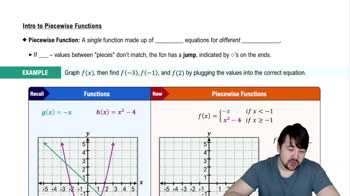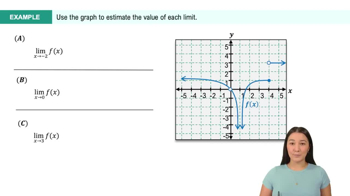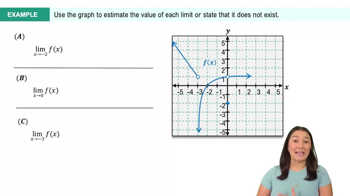Table of contents
- 0. Functions7h 52m
- Introduction to Functions16m
- Piecewise Functions10m
- Properties of Functions9m
- Common Functions1h 8m
- Transformations5m
- Combining Functions27m
- Exponent rules32m
- Exponential Functions28m
- Logarithmic Functions24m
- Properties of Logarithms34m
- Exponential & Logarithmic Equations35m
- Introduction to Trigonometric Functions38m
- Graphs of Trigonometric Functions44m
- Trigonometric Identities47m
- Inverse Trigonometric Functions48m
- 1. Limits and Continuity2h 2m
- 2. Intro to Derivatives1h 33m
- 3. Techniques of Differentiation3h 18m
- 4. Applications of Derivatives2h 38m
- 5. Graphical Applications of Derivatives6h 2m
- 6. Derivatives of Inverse, Exponential, & Logarithmic Functions2h 37m
- 7. Antiderivatives & Indefinite Integrals1h 26m
1. Limits and Continuity
Introduction to Limits
Problem 2.2.19
Textbook Question
Sketch a graph of f and use it to make a conjecture about the values of f(a), lim x→a^−f(x),lim x→a^+f(x), and lim x→a f(x) or state that they do not exist.
f(x) = {x^2+1 if x≤−1
3 if x>−1; a=−1
 Verified step by step guidance
Verified step by step guidance1
Step 1: Identify the piecewise function. The function f(x) is defined as f(x) = x^2 + 1 for x ≤ -1 and f(x) = 3 for x > -1. This means the function has two different expressions depending on the value of x relative to -1.
Step 2: Sketch the graph of f(x). For x ≤ -1, plot the graph of y = x^2 + 1, which is a parabola opening upwards with its vertex at (0, 1). For x > -1, plot the horizontal line y = 3. Note the point of transition at x = -1.
Step 3: Determine f(a). Since a = -1, use the expression for x ≤ -1, which is f(x) = x^2 + 1. Therefore, f(-1) = (-1)^2 + 1 = 2.
Step 4: Evaluate the left-hand limit, \( \lim_{x \to -1^-} f(x) \). As x approaches -1 from the left, f(x) follows the expression x^2 + 1. Thus, \( \lim_{x \to -1^-} f(x) = (-1)^2 + 1 = 2 \).
Step 5: Evaluate the right-hand limit, \( \lim_{x \to -1^+} f(x) \). As x approaches -1 from the right, f(x) is constant at 3. Thus, \( \lim_{x \to -1^+} f(x) = 3 \).
Recommended similar problem, with video answer:
 Verified Solution
Verified SolutionThis video solution was recommended by our tutors as helpful for the problem above
Video duration:
6mPlay a video:
Was this helpful?
Key Concepts
Here are the essential concepts you must grasp in order to answer the question correctly.
Piecewise Functions
A piecewise function is defined by different expressions based on the input value. In this case, f(x) has two distinct definitions: one for x ≤ -1 and another for x > -1. Understanding how to evaluate piecewise functions at specific points is crucial for analyzing their behavior and limits.
Recommended video:

Piecewise Functions
Limits
Limits describe the behavior of a function as the input approaches a certain value. The left-hand limit (lim x→a^−f(x)) and right-hand limit (lim x→a^+f(x)) are essential for determining continuity and the overall limit (lim x→a f(x)). Evaluating these limits helps in understanding how the function behaves around the point of interest.
Recommended video:

One-Sided Limits
Continuity
A function is continuous at a point if the limit as x approaches that point equals the function's value at that point. For the function f(x) at a = -1, checking continuity involves comparing f(-1) with the left-hand and right-hand limits. If these values do not match, the function is discontinuous at that point.
Recommended video:

Intro to Continuity

 6:47m
6:47mWatch next
Master Finding Limits Numerically and Graphically with a bite sized video explanation from Callie
Start learning




